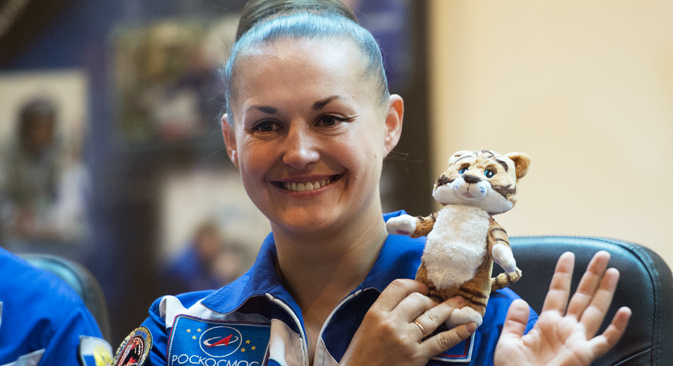
Roscosmos cosmonaut Yelena Serova during a news conference at the Baikonur Space Center prior to the launch of the Soyuz TMA-14M spacecraft. Source: Ramol Sitdikov / RIA Novosti
Yelena Serova became the fourth female cosmonaut in Russian space history and the first to enter orbit in 17 years. Serova is one of the crew members aboard the Soyuz-FG, which was launched on Sept. 26 on a mission to the International Space Station (ISS).
Serova, who was enrolled as a cosmonaut for the Russian Federal Space Agency, or Roscosmos, back in 2011, had expressed a keen interest in the scientific experiments being conducted onboard the ISS.
One of them is called Firestation, which is an experiment that researches atmospheric gamma flashes and optical glow during thunderstorms.
The expedition will last 170 days, during which time Serova plans to regularly call her family. “There is no problem with that. The ISS is now equipped with all the modern types of communications. There is IP telephony and e-mail,” the cosmonaut told RIA Novosti in an interview.
Serova, aged 38, is married to former cosmonaut and test pilot Mark Serov. They have an 11-year-old daughter.
Serova dreamed of becoming a cosmonaut even as a child. She was born in the small provincial town of Vozdvizhenka in the Ussuriysky District of the Primorsky Territory in the Russian Far East. Serova stayed true to her childhood dream and matriculated at the aerospace faculty of the Moscow Aviation Institute, where she received engineering qualifications. After defending her thesis, she got a job at the S.P. Korolev Rocket and Space Corporation Energia, a manufacturer of spacecraft. She transferred to the Mission Control Center in 2004.
After undergoing training at the Gagarin Research and Test Cosmonaut Training Center, Serova filled out an application for admission as a cosmonaut in 2005. A lengthy period of medical examination and approval of her candidacy ensued. She was admitted to general space training in 2007, and in 2009 she passed her exams and received qualifications as a test cosmonaut.
Serova’s final test was to survive in the desert as a crew member with Sergei Ryzhikov and Oleg Novitsky. In December 2011, she was appointed flight engineer for the Soyuz-TMA.
Serova said there is no discrimination in space. “At this stage of my preparation, I have been approved as a crew member at the same time that several of my male colleagues are still waiting for their hour of triumph,” she said.
“With regards to myself, I can say the following: There is an incredible burden on the woman because she has to be both a professional at work and a good housewife and mother.”
Serova is not intimidated by the hardships of space travel. “This is my job and my professional choice,” she said.
All rights reserved by Rossiyskaya Gazeta.
Subscribe
to our newsletter!
Get the week's best stories straight to your inbox